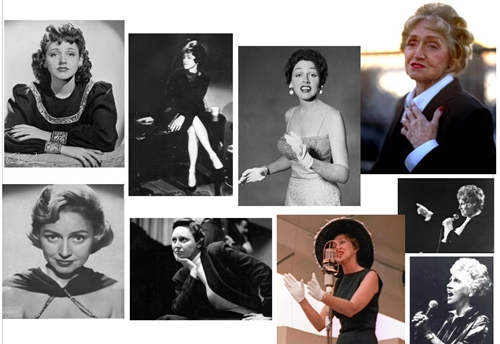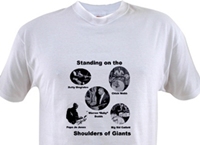
Anita's ability to sing in fast tempos set her apart from any of her peers in any of the eras in which she contributed memorable performances. This ability made her highly successful with Gene Krupa and his orchestra, and allowed her to seamlessly segue into bebop and beyond as the swing and big band eras died.
She also had long associations with other drummers, notably Don Carter and John Poole. Carter, her first husband, gave her drum lessons. Poole was her favorite drummer and she maintained a professional association with him that spanned over three decades.

Here is a great video of Anita and John Poole (see also the 1958 Newport Jazz Festival clip further on):
I consider her male counterpart to be Mel Torme, who shared her ability to sing in fast tempos, and was a solid drummer in his own right.
There are some excellent biographical sources that balance Anita's Jezebel antics with her musical accomplishments and contributions to jazz:
- John Poole's wife, Elaine, wrote a revealing biography, Jazz, Jail, and Genius: Adventures and stories of singer Anita O’Day and her drummer John Poole
- Anita's own autobiography, High Times, Hard Times, is as open and revealing as Elaine Poole's bio above.
I also highly recommend her bio pic, Anita O'Day - The Life Of A Jazz Singer, which comprehensively details her story without the usual embellishments or convenient lapses of less than flattering material that characterize many biographies. Other sources of information that I found to be balanced and accurate are Lara Pellegrinelli's 2002 article, Anita O’Day: Yesterday & O’Day, an NPR Jazz Profiles transcript produced by Joan Merrill, and a surprisingly complete Wikipedia entry. These two audio transcripts of NPR shows featuring Anita are also worth a listen: Anita O'Day: A Distinctive Voice Stilled and Anita O'Day: Revisiting A Classic Voice.
Personally I am not too fond of her early years (except for her stint with Krupa). I believe she hit her stride as an artist when the bebop movement started gaining attention; indeed, I believe that genre was perfect for her talents and musical gifts and set her well apart from any other vocalist of that era.
I have selected the following videos to show how she evolved throughout her career. The highlight for me is her performance at the 1958 Newport Jazz Festival, which was beautifully captured in Bert Stern's Jazz on a Summer's Day.
With Stan Kenton
At the 1958 Newport Jazz Festival(John Poole on drums)
Other Performances
Because her music spans many albums and genres I am reluctant to make firm recommendations. Here is a list of Anita O'Day Albums, ranked by highest reviewer ratings, that can guide you.
There are videos in addition to the ones I listed above that I do recommend: Jazz Icons: Anita O'Day Live in '63 & '70, Live in Tokyo '63 and Anita O'Day - Live at Ronnie Scott's all capture this great woman in excellent performances. Enjoy the music!



6 comments:
Thanks for this info about Anita O'Day and John Poole.
I'm writing an assignment about their recording of Love Me Or Leave Me on Anita Sings the Most (1957) with the Oscar Peterson Trio.
I need to find out what kind of drums (brand etc) John Poole played on this recording.
I've tried to make it out in the videos you have here but there isn't a clear shot.
If you also have any information his style of playing on Love Me Or Leave Me or how this was recorded that would be most appreciated.
Thanks
Joanna - John used Gretsch drums, but that may not be the case in a studio recording (although most jazz studios used Gretsch as their house kit. His sizes were 20x14 bass drum, 12x8 mounted tom and 14x14 floor tom (diameters x depth). I am sorry to say that I don't know how Love Me or Leave Me was recorded. As to his playing style, he was a master at accenting Anita's vocals, and she and he would often trade 8s.
My bad on the drum sizes. I have also seen him behind kits with 13x9 and 16x16 toms. Same 20x14 bass drum though.
John Poole played Tama drums and Slingerland drums.
DE Poole
anitaoday2.com
He may have played Slingerland in his early years since that was a very popular brand during the 1940s, and he and Anita also gave Buddy Rich a Slingerland Radio King snare drum as a gift. In his later years he may also have acquired a Tama kit, but I seriously doubt that he endorsed that brand. However, there is considerable video and photo evidence that his main brand of drums were Gretsch during the 1960s and late 60s and beyond. He was a George Way/Camco endorser for a period, which is evidenced in this circa 1961 flyer: http://www.volusiagig.com/music/pooleway1.jpg ... that brand eventually evolved into what today is a brand called Drum Workshop or DW.
Just found this blog today, so sorry for the late posting.
I met John Poole in Fairbanks, Alaska in summer of 1973. He had come up to play for four weeks at the Rendezvous Club with a trio, and needless to say, as a drummer myself, I was mesmerized. He was playing a Slingerland set, one he said belonged to Buddy Rich (it had his logo on it).
At the end of the gig, he packed up his kit and shipped it back, planning to stay for another couple of weeks just to enjoy the state. However, the club owner wanted them to play another week, so John borrowed my Rogers kit for that week. In exchange, he gave me a couple of lessons---exercises to build up hand speed and dexterity.
According to him, he taught Sal Mineo how to play drums for the Gene Krupa Story (Anita O'day was in that movie).
Post a Comment